I spent several hours yesterday doing an airspeed indicator calibration. I had done one before, back in April 2004, but I had some problems with the water manometer, which made me question the accuracy of my data. And I didn't do a very good job at recording EFIS airspeed data, so I didn't have a good handle on how accurate it was.
The EFIS had gone back to the vendor for a hardware upgrade a month ago, and the one I received had a different serial number from the one I sent. It was a major hardware upgrade, so they probably send out new units, and then rip the old ones apart for the components that can be reused. I was curious to see how the instrument error of the new EFIS compared to my original one.
This time I clamped some pieces of wood on either side of the clear tubing to keep it from moving around. Last time the tubing was just hanging, which allowed it to swing from side to side and set up some motion of the water inside. I also moved the tubing much more slowly when I was changing the water level, to be sure to stay on the same side of the hysteresis band. And I recorded more EFIS data, at a higher data rate (15 seconds at 8 records per second).
I finished crunching the data this morning. I was gratified to see that the general trend of the results were very similar to that I measured in April 2004. That means my previous data was probably better than I thought, my technique is repeatable, and the errors are relatively stable with time.
Note that there is a certain amount of error associated with each measurement, so the results are only approximate. The measurements of water manometer height are probably only good to 1/16 on an inch (this represents 1.2 kt at 40 kt, and 0.2 kt at 200 kt), and it is hard to read the analog ASI to better than half a knot. Thus the total error in this data is about 1.7 kt at 40 kt decreasing to 0.7 kt at 200 kt. The EFIS data resolution is 0.2 kt, so the total errors in the EFIS ASI error plots is about 1.4 kt at 40 kt, decreasing to 0.4 kt at 200 kt.
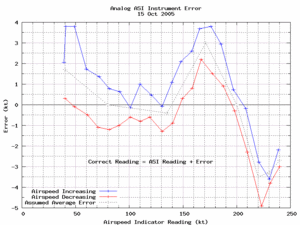 Here is the latest data for the analog ASI. The range of interest for normal operations is from about 50 kt (stall speed) to 200 kt (Never Exceed Speed). I will do some flight testing in excess of 200 kt, so I did the calibration out to about 240 kt.
Here is the latest data for the analog ASI. The range of interest for normal operations is from about 50 kt (stall speed) to 200 kt (Never Exceed Speed). I will do some flight testing in excess of 200 kt, so I did the calibration out to about 240 kt.
The hysteresis in the analog ASI is not surprising, as it is a mechanical instrument with some internal friction.
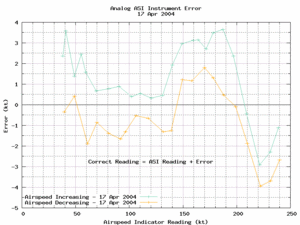 Here is the data from last year. You can see that it is quite similar to yesterday's data.
Here is the data from last year. You can see that it is quite similar to yesterday's data.
 This plot shows both sets of data for the analog ASI. The two sets of data compare very well, taking into account the errors inherent in the measurements (about 1.7 kt at 40 kt decreasing to 0.7 kt at 200 kt).
This plot shows both sets of data for the analog ASI. The two sets of data compare very well, taking into account the errors inherent in the measurements (about 1.7 kt at 40 kt decreasing to 0.7 kt at 200 kt).
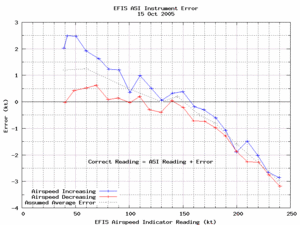 Here is the latest data for the EFIS ASI. I compared the EFIS ASI screen indications to that shown on the data stream, and they seemed to match up perfectly (as they should). I used the EFIS data values for these plots, as they had more resolution than I could have read from the screen.
Here is the latest data for the EFIS ASI. I compared the EFIS ASI screen indications to that shown on the data stream, and they seemed to match up perfectly (as they should). I used the EFIS data values for these plots, as they had more resolution than I could have read from the screen.
The apparent hysteresis in the EFIS ASI has me puzzled. I don't know if this hysteresis is in the EFIS, or maybe it is in the water manometer. It is possible that I am slightly misreading the manometer due to the viscosity as the water moves in the tube between test points. This error would be in the correct sense to at least partially explain the apparent hysteresis.
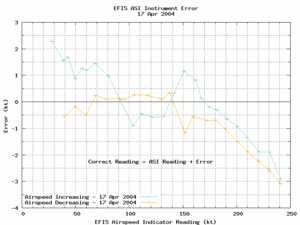 This plot shows the data from last year for the EFIS ASI. The results look quite "noisy" in the range of 90 to 150 kt. I was having problems with the plastic tubing for the manometer swinging around, which would start the water moving, which probably reduced the hysteresis, and reduced the accuracy of my measurement of the water height. I have a lot more confidence in yesterday's data.
This plot shows the data from last year for the EFIS ASI. The results look quite "noisy" in the range of 90 to 150 kt. I was having problems with the plastic tubing for the manometer swinging around, which would start the water moving, which probably reduced the hysteresis, and reduced the accuracy of my measurement of the water height. I have a lot more confidence in yesterday's data.
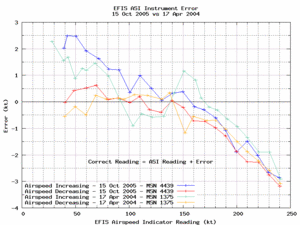 This plot shows both sets of data for the EFIS ASI. The general trend is surprisingly similar to the original EFIS. I'm scratching my head trying to figure out if there could possibly be some sort of systematic error in my test technique, but I think this is more likely a sign of manufacturing consistency in the sensors used in the EFIS.
This plot shows both sets of data for the EFIS ASI. The general trend is surprisingly similar to the original EFIS. I'm scratching my head trying to figure out if there could possibly be some sort of systematic error in my test technique, but I think this is more likely a sign of manufacturing consistency in the sensors used in the EFIS.